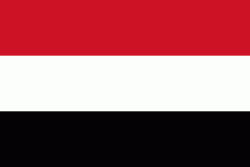Yemeni rial
ï·¼
The rial (ريال يمني; sign: ﷼; abbreviation: YRl (singular) and YRls (plural) in Latin, ,ر.ي in Arabic; ISO code: YER) is the official currency of the Republic of Yemen. It is technically divided into 100 fils, although coins denominated in fils have not been issued since Yemeni unification. Due to the ongoing political instability, the value of Yemeni rial continues to fall.The Yemeni Civil War has caused the currency to diverge. In southern Yemen, which is primarily controlled by UAE-backed separatists and the former government backed by Saudi Arabia, ongoing printing has caused the currency to plummet into freefall. In northern Yemen, which is primarily controlled by Ansar Allah with support from Iran, banknotes printed after 2017 are not considered legal tender, and therefore, the exchange rate has remained stable. The differences in banknotes printed before and after 2017 can be determined by its size.
In the 18th and 19th century, the riyal was traditionally associated with the Maria Theresa thaler, a currency that was widely in use in Yemen owing to the Mocha coffee trade with the French, and a Yemeni request that its produce be paid with thalers.
As Yemen progressed, it developed its own legal currency. After the union between the North (the Yemen Arab Republic) and the South (the People's Democratic Republic of Yemen) in 1990, both the northern rial and the southern dinar remained legal tender during a transitional period, with 1 dinar exchanged for 26 rials. On 11 June 1996, the dinar was withdrawn from circulation. In 1993, the first coins were issued for the Republic of Yemen. The value of the Yemeni rial against the United States dollar dropped significantly, compared to 12.01 rials per dollar in early the 1990s. Since the mid-1990s, the Yemeni rial has been freely convertible. Though it dropped from YRls 20 to approximately YRls 215 against the US dollar since then, the rial has been stable for several years. However, since 2010 the Central Bank of Yemen had to intervene many times, resulting in a serious decline of foreign reserves. By late 2013, the Economic Intelligence Unit expects reserves to decline to approximately 1.3 months of imports over the following years, despite information that Saudi Arabia would transfer $1 billion to the Yemeni Central Bank. Due to the war, the exchange rate for the Yemeni rial has hovered between 470 and 500 Yemeni rials for 1 US dollar.
Country
-
Yemen
Yemen (ٱلْيَمَن), officially the Republic of Yemen, is a country in Western Asia.
It is situated on the southern end of the Arabian Peninsula, and borders Arabia to the north and Oman to the northeast and shares maritime borders with Eritrea, Djibouti and Somalia. Yemen is the second-largest Arab sovereign state in the Arabian Peninsula, occupying 555,000 km2, with a coastline stretching about 2000 km. Its constitutionally stated capital, and largest city, is Sanaa. As of 2023, Yemen has an estimated population of 34.2 million.
